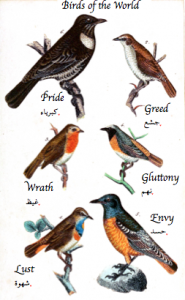Birds to Watch Out For
May 7th, 2014
 For this piece, I drew on Farid ud-din Attar’s The Conference of the Birds which we read for section earlier in April. I have used a birdwatching manual and have written 6 of the “7 deadly sins” both in English and in Arabic. The concept of “Seven Deadly Sins” is a Christian one. The flaws described in The Conference of the Birds are not as easily reduced. Yet, though more nuanced, many of the same themes appear in the stories of the different birds.
For this piece, I drew on Farid ud-din Attar’s The Conference of the Birds which we read for section earlier in April. I have used a birdwatching manual and have written 6 of the “7 deadly sins” both in English and in Arabic. The concept of “Seven Deadly Sins” is a Christian one. The flaws described in The Conference of the Birds are not as easily reduced. Yet, though more nuanced, many of the same themes appear in the stories of the different birds.
My decision to use a bird watching manual was twofold. First of all, birds and their stories in The Conference of the Birds are catalogued in a manner similar to a list of birds. Each bird: parrot, peacock, hawk, nightingale etc is recorded along with their character traits. Secondly, I believe that, like a birdwatching manual, the stories in The Conference of the Birds serve as a guide, but a moral guide. The stories are like cautionary tales. Each bird’s story has a human counterpart, and each bird exemplifies a flaw that is also found in humans. For example, the story of the nightingale, who is infatuated with a rose, is mirrored by the story of a dervish, infatuated with a princess. In both stories, superficial desires are rendered futile as the love is unrequited and unattainable. We are encouraged not to lose sight of the purpose of our own lives through infatuation with another.
My choice to use the Arabic name for the sins was an aesthetic attempt to connect this piece back to its “Islamic” inspiration. I also find the Arabic text more visually appealing, thus it lends more artistry to the work which otherwise would have the dryness of scientific manual. Finally, the Arabic flair indicates that this manual has a hidden dimension, which it does. These birds are more than objects of curiosity, they are also representative of moral flaws that we may find in ourselves.
Leave a Reply